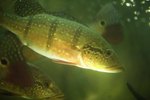Nothing adds color to your freshwater aquarium quite like the glofish. The unique ability to glow brightly makes raising the fish fun for kids and adults alike. This hardy little fish is a fairly easy keeper that thrives in a tropical, warm tank environment. In general, they are much like other aquarium fish and do not require specialized care.
Description
Glofish are a product of science that were created by inserting fluorescent protein genes from sea coral into zebra, or danio, fish. Scientists originally bred the glofish to detect pollution in waterways. The glofish has the long, slender body of the zebra fish with a mouth that turns upward. They generally are bright red, green, orange or yellow in color.
Habitat
Glofish like a tropical environment with warm water. The temperature should remain between 72 and 80 degrees Fahrenheit. However, the hardy glofish can live in temperatures down to 62 degrees. Avoid drastic temperature changes to help prevent stress in your fish, which often leads to illness. Also, lighting the tank during the day helps reduce stress. They are schooling fish and like to be kept in groups; generally four to eight fish live happily together in an average-sized tank. Test the water about once a week, and make sure the pH remains between 6.8 and 7. Visit your local fish store for an aquarium test kit.
Feeding
Like their sister zebra fish, glofish eat almost any type of commercial fish food suitable for aquarium fish. They will eat live, frozen or flake fish food. Consider feeding your glofish a small amount of food twice a day. When feeding frozen food, thaw it first. They should be able to eat the entire amount within five minutes. Allow them to clean up all of the food before adding more, since leftover food may pollute your tank.
Maintenance
At least once a month, do a partial water change of 10 to 25 percent. This helps remove waste and keep the environment safe for your glofish. Use a tank filter to help remove harmful waste. Also, place a thermometer and water heater in your tank to ensure the temperature is regulated. Inspect your glofish often. Healthy glofish have clear eyes, a healthy appetite and even coloring that is bright, and they swim actively.
References
Resources
Writer Bio
Amanda Maddox began writing professionally in 2007. Her work appears on various websites focusing on topics about medical billing, coding, real estate, insurance, accounting and business. Maddox has her insurance and real estate licenses and holds an Associate of Applied Science in accounting and business administration from Wallace State Community College.




